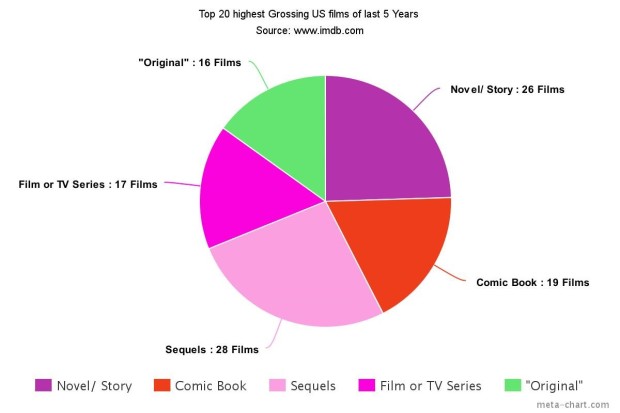Walking into a movie theater last week I noticed that nearly all of the films being advertised were for sequels or adaptions of already existing franchises. As I settled down with my popcorn to watch the film I had come to see (itself the 7th episode in a series called Star Wars—you might have heard of it), I tried to remember the last film I saw in theatres that wasn’t based on a pre-existing story. From adapted novels and comic books, to sequels, to films based on TV shows or even other films, pre-packaged narratives seem to dominate the contemporary film landscape. In this post I examine what originality looks like in popular US film.
By taking a short look at the most popular films of the last half-decade, the depth of US fascination with follow-ups and adaptations becomes clear. Out of the top 20 US grossing films of each of the last 5 years (a total sample size of 100 films) 84% were either based on a piece of literature (novel, comic, fairytale), a direct sequel to another film (e.g. 2010’s Toy Story 3), or based on another film or TV show (e.g. 2014’s Godzilla). Only 16% of top-grossing US films could then be considered “original”, or developing a narrative that is not derivative of another text in any major way.

Of the 16% of films that were not based on other media, a few notable categories can be clearly defined:
Biographies: These films tell the “true” life story of a person or group of people. Examples are Lincoln (2012), American Sniper (2014), and Straight Outta Compton (2015). These films were among the best reviewed and highest grossing of the non-adaptions. However, some might argue that these films are not “original” narratives because they take their source material from the lives of already extant people (American Sniper for instance is directly influenced by Navy Seal Chris Kyle’s autobiography). Biographies like these are interested in introducing, or re-introducing, a well-known person to the movie-going public and therefore play into America’s taste for a familiar story told in a new way, a primary draw biographies share with many adaptations.
Comedies: Offering irreverent entertainment without the burden of extensive plot or narrative, comedies like Adam Sandler’s Grown Ups (2010), Family Guy creator Seth MacFarlane’s Ted (2012), and the Seth Rogan frat-meets-family vehicle Neighbors (2014) represent an uninspiring picture of creativity in popular US film. While these films may certainly have their fans, and many made a considerable amount of money, it is hard to make the argument that a film based on a foul-mouthed teddy bear is a high-water mark for artistic expression.
Animated Films: Making up the majority of “unique” popular films are digitally animated children’s movies such as Frozen (2013), Home (2015) and Inside Out (2015). And while at first it may seem disappointing to more distinguished film fans that children’s films make up the majority of “original” popular films, these stories often take up progressive social issues in ways that are ignored by many “serious” films. Disney’s Brave (2012) was praised for its representation of its protagonist Merida, a strong female character that defied the company’s long-established trope of the helpless princess awaiting rescue and also rejected the traditional waif-like body of Disney women for a more positive and realistic body shape. 2015’s Inside Out contained an underlying message about mental health, depression, and emotional stability that was surprisingly complex and nuanced for a film targeting younger audiences. Far from being the throw-away fluff that children’s films are often perceived to be, these “original” animated films develop new ways of imagining the world, rather than reformulating tried and tired narratives.
The “Man Story”: There are a small number of notable films that are exceptional in that they are neither adapted from other media, nor one of the three categories listed above. They include Tarantino’s Django Unchained (2012), David O. Russell’s American Hustle (2013), and Christopher Nolan’s Interstellar (2014). These films deal with the past, present, and future of a uniquely American mythology of masculinity, simultaneously leveling critiques of US racism, capitalism, and imperialism without disrupting their underlying status-quo of American male exceptionalism. These films may be “original” in many ways, but are firmly rooted in perspective of the boot-strapping, frontiersman, US male who learns to dominate his environment and the women around him.
I am by no means suggesting that films that adapt other texts are in any way deficient compared to films of unique inception in terms of creativity, expression, or reception. Remediation and adaptation have always been popular and successful techniques in cinema. However, I do think it worth-while to examine the “original” films that compose this small sampling of texts, and think about what it means to tell a unique story in film. As a scholar of both literature and film, I find that adaptations can be the entry-point into a number of compelling critical conversations about authorial agency, visual rhetorics, and representation. Adaptations can also be an excellent way of getting students whose main experience of textuality is through popular media like film and television to engage with literary texts. However, I believe it is also important to give credit to those films that do take the leap into new realms of creativity, using the medium of film to transcend the familiar rather than rehash, reboot, and remake the stories we already know.
Max Cassity is a 2nd year PhD student in English and Textual Studies. His studies encompass 20thand 21st Century American fiction, poetry, and digital media. He is currently beginning a dissertation that studies fictional representations of epidemic diseases in American and Global modern literature and digital narratives including Ebola, Cancer, and Pandemic Flu.

You must be logged in to post a comment.